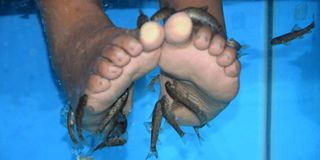Premium
How to take care of your feet

Taking care of your feet when you have diabetes requires a lot of care and knowledge.
What you need to know:
- Wash your feet daily with lukewarm water.
- Check your blood sugar on a daily basis.
- Do not walk barefoot.
- File your toes across with an emery board instead of using a nail cutter.
Look down. Can you see your feet? What do you think of them? Are they small and dainty, pretty in pink or red or they make for great galoshes and you’re proud of them? Feet do a lot of work, and they are the most neglected part of the body.
More than the back because back pain reminds you of that vast expanse behind you. With their collection of 26 bones, the feet are at once delicate and powerful. They also need far more care than you have been giving them.
Feet can tell us a lot about our health, from the total absence of hair, a foot ulcer that won’t heal, thick yellowing toenails to cold feet, your lower extremities do a lot of heavy lifting. If you, like a growing number of Kenyans have diabetes, then you must have a deeply personal relationship with your feet.
Research says “diabetes is a global pandemic affecting over 425 million people worldwide. In Kenya, an estimated 460,000 people are living with diabetes, and estimates indicate that this set to rise to over 1.3 million people within a generation.”
Diabetes
It is also estimated about 40 per cent of Kenyans who are diabetic do not know that they have it. Why, you may ask, are you reading this from a fashion and beauty writer? Because rising cases in diabetes mean the way foot care is practised at home and in salons needs to change. Aside from that, diabetics have sensitive feet.
Taking care of your feet when you have diabetes requires a lot of care and knowledge of do and dont’s. Take note if your feet feel tingly, are cracked or have grown sore. If your feet are getting cold or numb, you may want to check in with your doctor. Here is how to you need to do to care for your feet:
- Inspect your feet daily. Use a mirror if you can’t twist and see the bottom of your foot. Look out for anything suspicious or unusual including cuts, bruises, blisters or sores. Be thorough in your examination. Should any anomaly occur, you would know immediately and do what is needed to fix it.
- Wash your feet daily with lukewarm water. You can add epsom salts and reward yourself with a 10 to 15 minutes foot soak. Wipe your feet dry including in between your toes, and apply Vaseline, massaging it into your feet and toes, but do not moisturise in between the toes. It will encourage fungal growth.
- Check your blood sugar on a daily basis. What does that have to do with anything? Spikes in blood sugar can, according to WebMD, cause poor blood flow and nerve damage to your feet. Symptoms may include foot numbness, sores and lingering infections, which could cost you a leg - literally. - Avoid heating pads or hot water bottles and always use moderate temperatures when caring for your feet.
Clean socks
- Do not walk barefoot. Yes, even at home. Protect the soles of your feet; whether you are walking on the beach, the pavement or the floor.
- Change your shoes. Don’t wear the same pair day in day out. If you are a sock-wearer, make sure those are clean socks every single day. You could buy diabetic socks. They are designed to mitigate and prevent foot injuries.
- Buy, and use your own pedicure kit. Do not share foot care equipment. Do not attempt to treat any ingrown toenails and do not shave off calluses. If you have to have a pedicure in the salon, instruct them on how to take care of your feet. For example, all that aggressive scrubbing with a metallic foot scrubber is NOT good for your feet. Yours need kinder care. Carry your pedicure kit to the salon and have them use that. And be sure to check or ask if they sanitise their foot baths.
- Don’t let your feet get sweaty. Use antiperspirants, wear cotton socks or use foot powder.
- File your toes across with an emery board instead of using a nail cutter. Do not cut the corners of your toenails as that could lead to nicks that leave your feet open to infection. - Have you ever heard of the legs-up-the-wall yoga pose? Do that at the end of the day as a form of relaxation. - Do not wear flip flops outside the shower or home, and do not wear totally flat shoes that do not offer any arch support. Women, no ballerina flats. Get a pair of moccasins/loafers. That one inch makes a huge difference. They are also far more stylish than any old ballerina flats.
- Finally, make your doctor your friend. Think of your relationship as collaborative. They do their part to treat you and monitor you, but you do your part by taking care of yourself from the feet up.





